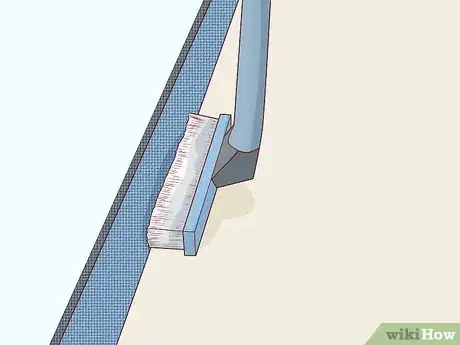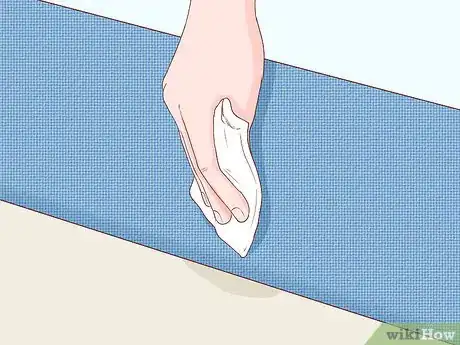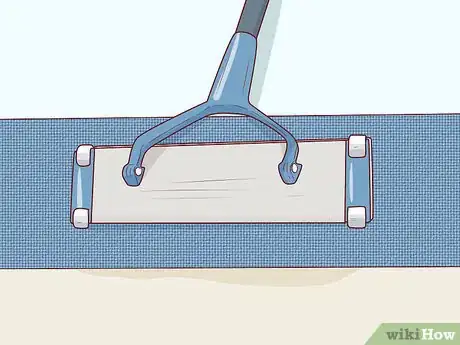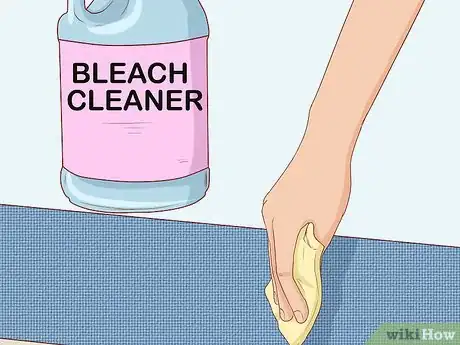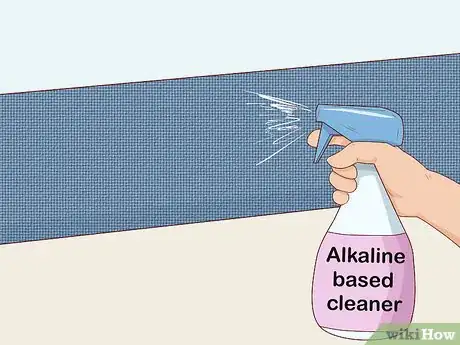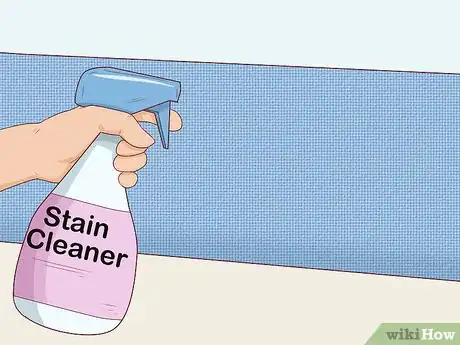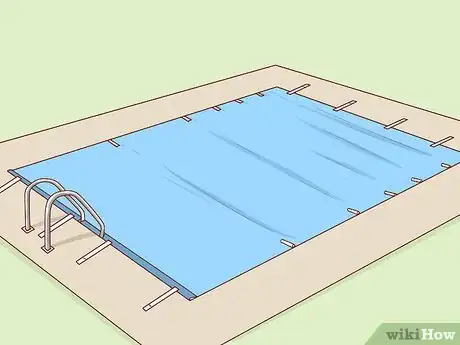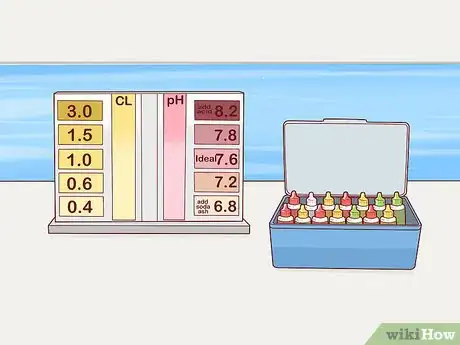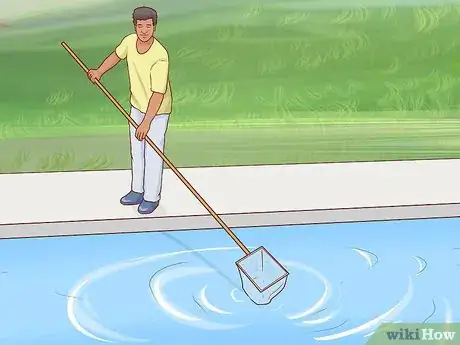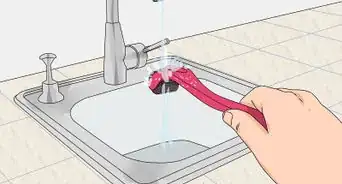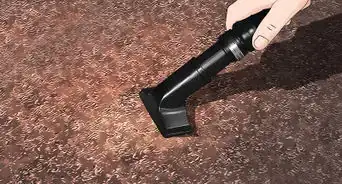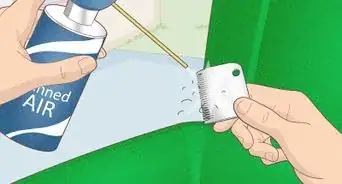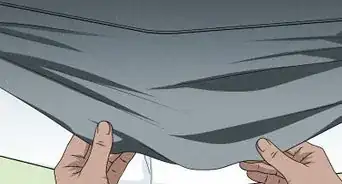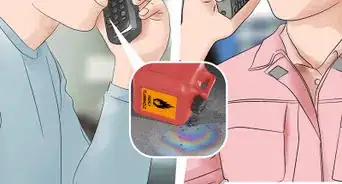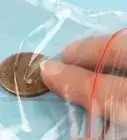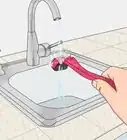This article was co-authored by Rob Litman. Rob Litman is a Landscaper, General Contractor, and the CEO of Vitoli Inc., a landscaping, hardscaping, ecoscaping, and swimming pool design company in Los Angeles, California. With over 20 years of experience in construction, Rob specializes in energy-efficient and drought-tolerant landscaping. He holds General Building Contractor (Class B) and Registered Pool/Spa Contractor Licenses. In 2007, Rob won House of the Year in Gardena, California.
This article has been viewed 108,435 times.
The vinyl pool liner in your pool is designed to add a nice finish to the bottom and sides of your pool. It also prevents the growth of algae, bacteria, and fungus in the pool. Over time, the pool liner can fade or accumulate stains and dirt. To clean a vinyl pool liner, you can brush, wipe, and vacuum it. You can also apply cleaners to the liner to clean it. Once it has been cleaned, you should maintain the pool liner so it looks its best.
Steps
Brushing, Wiping, and Vacuuming the Liner
-
1Clean the liner with a pool brush. To remove surface dirt and grime on the pool liner, use a pool brush with nylon or plastic bristles. Pool brushes are curved and often come with an extendable handle, making it easier for you to clean the pool liner. Run the brush over the liner to remove dirt and debris. Make sure you clean the sides and the bottom of the liner.[1]
- You can dip the brush in a bucket of pool water to clean it as you go. The pool brush should remove surface dirt and grime easily off of the liner.
- To address any dirt on the liner that is below the water line of the pool, drain the pool and use the brush to get at these spots.
-
2Wipe the liner with a clean cloth. You can also clean any thick marks on the liner with a clean towel or cloth. Dip the towel in the pool water and wipe off the marks. Using the pool water can make wiping off marks or dirt on the liner easier.
- This option may be better for spot cleaning any trouble areas on the liner. You may keep a clean cloth on hand to wipe off dirty spots on the liner when they start to appear.
Advertisement -
3Vacuum up any algae or debris on the liner. Get a pool vacuum that has a tele-pole, a vacuum head, and a vacuum head. Make sure the vacuum head is made for a vinyl pool liner, as it will have brushes so it does not snag the liner. The vacuum can be used to remove debris and algae on the pool liner.[2]
- The pool vacuum works by attaching the vacuum hose to the skimmer or vacuum line in the pool. Run the vacuum against the pool liner to remove debris and algae. Any dirt or debris will go through the hose to the pump basket and filter.
Applying Cleaners to the Liner
-
1Apply a bleach cleaner to the liner. If you notice that bacteria or fungus has stained the liner, use a bleach based cleaner. These stains will look like dark spots on the liner. Combine one part chlorine bleach and one part water. Use a spray bottle or a small garden sprayer to apply the bleach cleaner to the liner. Let the cleaner dry on the liner so it can remove the stains.
- You can clean any spots on the liner while the pool is full by applying the cleaner above the water line. Or you can drain the pool to clean the entire liner.
- Wipe off any excess bleach cleaner on the liner once the stains have been removed. Rinse the liner with water so there is no remaining bleach on the liner.
- Be careful when using bleach. Wear gloves when you touch the bleach and do not ingest any of the bleach.
-
2Use an alkaline based cleaner. Look for alkaline based cleaners for vinyl pools at your local hardware store or online. Alkaline based cleaners will be gentler on the vinyl than acid based cleaners and work well on stains or discoloration. Apply the cleaner using a spray bottle or a small garden sprayer.
- Once the cleaner has been applied and the stains or discolorations have been removed, make sure you rinse the liner well with water.
-
3Try a stain remover. If you have stains and scum on the pool liner, you can use a stain cleaner made for vinyl pool liners. Look for stain cleaners at your local hardware store or online. You can find ones that come in the form of an eraser that you can attach to an extendable pole. You can then wipe off stains like algae, rust, paint, and oil.[3]
- You can use the stain remover on specific spots on the liner with the pool still full of water. Or you can drain the pool to remove stains on the entire liner.
- Make sure you rinse the stain remover tool well once you are done using it. Use clean water and let it air dry outside. This will ensure the chlorine in the pool does not deteriorate the tool over time.
Maintaining the Pool Liner
-
1Use a pool cover. To keep the pool liner clean, use a pool cover when you are not using the pool often. You may do this during the winter time to protect the pool liner. Get a pool cover that fits the pool well and is tightly sealed at the edges. This will keep dirt and debris out of the pool, which can then create stains on the liner.[4]
- If you are using a pool cover that floats over the pool, make sure you lift the edge of the cover every few weeks to confirm no leaves or debris has gotten into the pool.
-
2Have the proper chemical levels in the pool. Most pools will self clean and maintain themselves well if there are proper chemical levels in the pool. To ensure the pool liner stays clean, check that the pool’s alkalinity, calcium hardness, pH, and chlorine levels are correct. You can use a testing kit to determine the chemical levels in the pool. Test the levels once a week to ensure they are correct.[5]
- In a standard size pool, the recommended chemical levels are a pH of 7.4-7.8, a total alkalinity level of 100-150 ppm (parts per million), and a calcium hardness of 200-250 ppm.
- The chlorine level in a non heated pool should be 1-3 ppm and the chlorine level in a heated pool should be 2-4 ppm.
- If you are covering your pool with a pool cover during the winter, reduce the amount of chemicals in the pool by 60%.
-
3Clean the pool regularly. Maintain the pool liner by cleaning your pool at least once a week. Use a skimmer to remove any leaves, dirt, and debris on the surface of the pool. Vacuum the pool to remove algae. Brush the pool liner with a pool brush to get rid of dirt before they become stains.
- A vacuum can do wonders for the color of your pool. Best of all, they aren't super expensive—most vacuums won't even reach $200.
- You may consider getting the pool professionally cleaned once a year, especially if you use it often.
Community Q&A
-
QuestionIs it okay to drain a vinyl pool completely?
 Community AnswerNo, you should never fully drain your vinyl pool. It can cause the vinyl to shrink or come loose. If you have an in ground pool, it can also cause the walls to potentially collapse.
Community AnswerNo, you should never fully drain your vinyl pool. It can cause the vinyl to shrink or come loose. If you have an in ground pool, it can also cause the walls to potentially collapse.
Things You'll Need
Brushing, Wiping, and Vacuuming the Liner
- A pool brush with nylon or plastic bristles
- A clean cloth
- A pool vacuum
Applying Cleaners to the Liner
- Bleach
- An alkaline cleaner
- A stain remover
Maintaining the Pool Liner
- A pool cover
- A testing kit for the pool
References
- ↑ http://blog.intheswim.com/cool-pool-tools-for-a-clean-pool/
- ↑ http://blog.intheswim.com/cool-pool-tools-for-a-clean-pool/
- ↑ http://blog.intheswim.com/cool-pool-tools-for-a-clean-pool/
- ↑ http://www.linerpoolrenovations.com.au/pool-liner-care/
- ↑ http://www.linerpoolrenovations.com.au/pool-liner-care/
About This Article
To clean a vinyl pool liner, use a pool brush to scrub the sides and bottom of the liner. Alternatively, use a clean cloth to wipe off any dirt or marks. If you notice dirt beneath the water line, you’ll have to drain the pool to clean the liner. For any bacteria or fungus stains, use a bleach or alkaline-based cleaner to break down the grime. Just spray the product on your liner and leave it to soak for a few minutes before scrubbing the dirt off with your brush or cloth. Afterwards, clean your pool liner at least once a week to keep it free of any dirt and debris. For more tips, including how to use a pool cover to keep your pool clean, read on!
